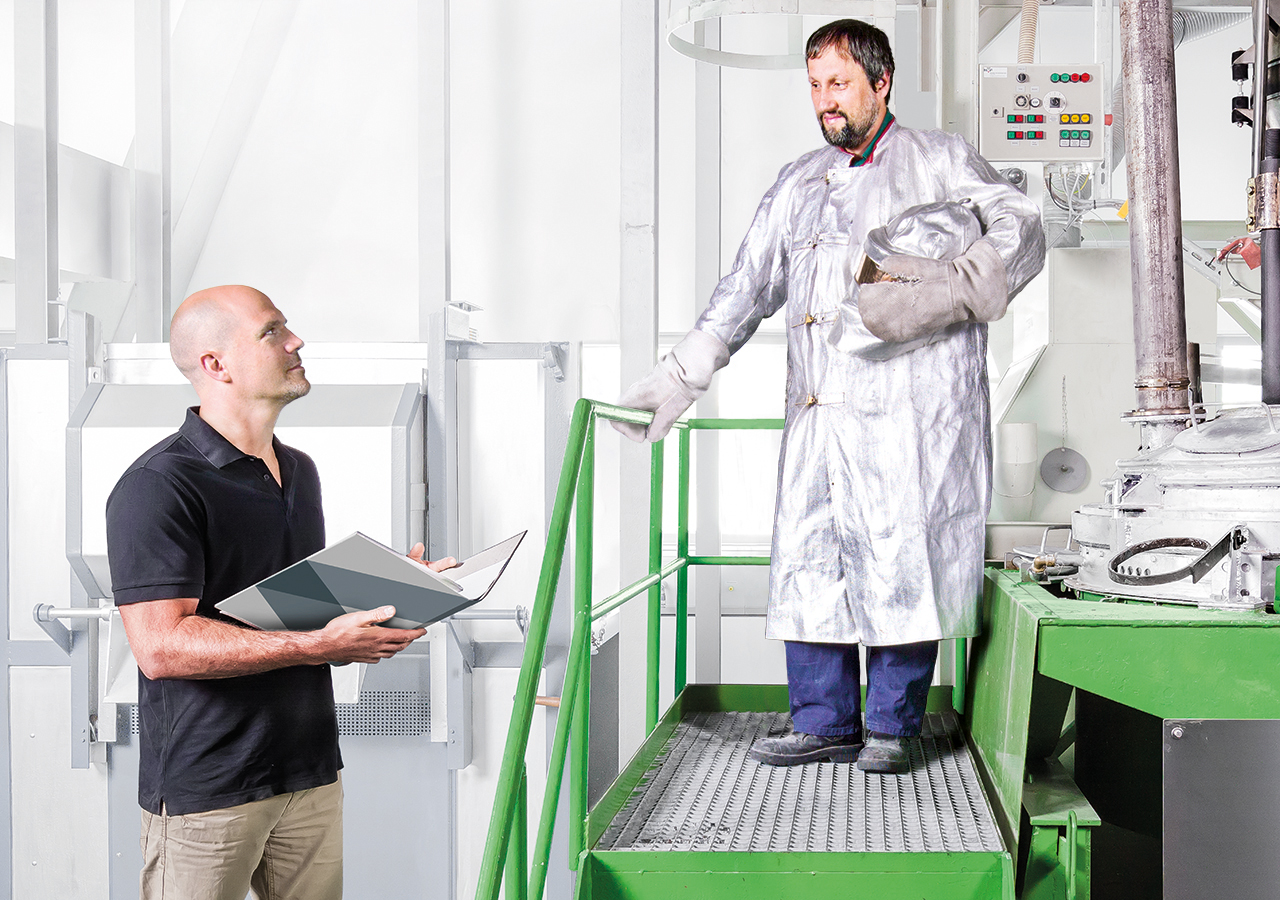
Dr.-Ing. Christian Adam and Dr. Burkhart Adamczyk after a melting experiment with the small-scale electric arc furnace
Source: BAM
"We view safety as a team sport."
Interview with Dr.-Ing. Christian Adam, Thermochemical Residues Treatment and Resource Recovery Division
How long have you been working for BAM and what are your responsibilities?
I have been working on thermochemical methods at BAM for treating residues and resource recovery since 2004. Focusing on that key point, I have led the Thermochemical Residues Treatment and Resource Recovery Division since 2012.
BAM’s mission statement says: "We are working for a strong safety culture in Germany and safety standards that meet our future’s highest requirements." What contribution do you make to safety in technology and chemistry with your work?
Our division is working on thermochemical processing methods for moderately environmentally hazardous waste. The continuous objective is to increase the environmental compatibility of materials and processes. Furthermore, the process developments usually lead to the recovery of valuable materials thus saving primary raw materials. This contributes to the security of supply in Germany with strategically important raw materials.
What has been your most exciting task or most exciting project?
I found the coordination and scientific management of an EU project on phosphorus recovery from sewage sludge ash to be the most exciting. Within the framework of the project, a demonstration installation was built at a project partner’s site based on our research. The entire range of topics around nutrient recovery from biogenic ash has expanded over the years and is now an important part of our division’s work.
What do you love about your work? What inspires you?
I want to explore new things and preferably develop meaningful and applicable things for people and the environment. It is a great moment for us, and a sign that our work has a direct impact if a residue treatment process developed by us is implemented on a large scale in the form of an industrial installation. That is what inspires me.
What are the three most important conditions for knowledge transfer and cooperation within BAM for you?
A successful knowledge transfer can be achieved in close cooperation with industrial partners and other scientific institutions. The collaboration on joint research projects at the national or international level is a very direct path for knowledge transfer. The cross-divisional collaboration on projects is the key for cooperation within BAM as well.
What would you answer to an applicant’s question: "Why is it worthwhile working for BAM?"
Working for BAM means that one is repeatedly confronted with new scientific challenges. The exciting topics are never exhausted and BAM offers excellent facilities as well as an excellent scientific environment in order to successfully execute these topics. BAM offers a very wide spectrum – from fundamental research to highly applied research – as well as the opportunity for interdisciplinary work.
Interview with Dr. Burkhart Adamczyk, Thermochemical Residues Treatment and Resource Recovery Division
How long have you been working for BAM and what are your responsibilities?
I have been working as a scientific associate for BAM since 2001. In addition to the acquisition of third-party funding and the publication of current research findings, my tasks include the planning, execution and evaluation of high-temperature experiments at different furnace units and in particular with an electric arc furnace. These are used to develop and identify new ways for recovering valuable materials from previously unusable inorganic residues and their conversion into useful products.
BAM’s mission statement says: "We are working for a strong safety culture in Germany and safety standards that meet our future’s highest requirements." What contribution do you make to safety in technology and chemistry with your work?
Many industrial residues must be landfilled due to their harmful composition to humans and the environment. The valuable materials they still contain are thus lost. We identify ways to harness these residues and obtain the valuable materials. Thus, our work not only enables the reduction of the hazard potential generated by many residues but we also exploit anthropogenic sources of raw materials. Thus we make an important contribution to closed substance cycle management in times of an increasing scarcity of resources and the environmental impacts associated with their exploitation.
What has been your most exciting task or most exciting project?
I find it difficult to choose because each project was exciting in its own way. Recovering metals from a steelworks slag was perhaps the most exciting. We unexpectedly found that after treating an inferior slag in our electric arc furnace, it exhibited the quality and the properties of cement and thus became a high-quality product – something that the steel industry has been trying to achieve for many years. Surprising results are almost always the most exciting ...
What do you love about your work? What inspires you?
The work should be varied and offer the opportunity to always tackle something new. It should include a balanced mix of scientific questions and technical challenges. Sufficient opportunities for applied work and preferably direct practical relevance that offers sufficient space for new paths are also important. Finally, the topics must also evoke curiosity, and I don’t mind if the resolution of a question triggers two new ones...
What are the three most important conditions for knowledge transfer and cooperation within BAM for you?
Flexibility, curiosity about new things that goes beyond one’s own horizon and, of course, team spirit.
What would you answer to an applicant’s question: "Why is it worthwhile working for BAM?"
Such a question can be answered with three arguments: varied topics with current references and new challenges; high level of expertise and modern equipment that is unique in Germany; application-oriented and interdisciplinary research in close cooperation with industry and other research institutions.


